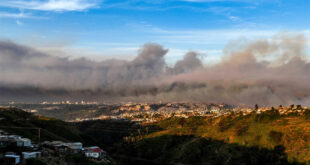Many vessels cannot pass under several Ho Chi Minh City bridges that are too low at high tide.
Binh Phuoc 1 Bridge, which crosses the Saigon River to link Thu Duc City with District 12, sees hundreds of vessels pass each day.
But the bridge stands only five-six meters above the water surface at high tide, making it difficult for large vessels to get through.
Empty ships with no cargo weighing them down “easily get stuck” underneath the bridge, said Van Khang, owner of a vessel he uses to transport goods from Binh Duong Province to HCMC.
Khang said he has to carefully watch the tide schedule to avoid high tide. But when his trips experience delays and he arrives late, there’s nothing he can do but wait for high tide to drop.
 |
|
The girder area (in red circle) of Binh Phuoc 1 Bridge across the Saigon River in HCMC is damaged after being hit by an unidentified vessel, August 2022. Photo by VnExpress/Gia Minh |
Seven kilometers away, Binh Trieu Bridge 1, which links Thu Duc City with Binh Thanh District, is another obstacle for vessels on the Saigon River.
Built before 1975, the bridge was expanded in 2010, but it rises just 5.5 meters above the surface of the water.
Even at low tide, vessels can only get through when they carry no more than three layers of containers.
The government regulates how high a bridge must be based on the size of the waterway it crosses.
As regulated, the height for both Binh Phuoc 1 and Binh Trieu 1 must be between seven and 9.5 meters.
 |
|
A container vessel waits on Thanh Da Canal for the tide to fall to get through Binh Trieu 1 Bridge in early 2023. Photo by VnExpress/Gia Minh |
Aside from the Saigon River, many bridges crossing canals in the city have also been built too low for local vessels to transport goods and passengers.
In southern HCMC, Rach Doi, Rach Dia and Long Kieng bridges along Le Van Luong Street in Nha Be District stand only a meter above the canals beneath them during high tide.
In HCMC’s District 1, Bui Huu Nghia and Tran Khanh Du bridges are only 2m above the Nhieu Loc – Thi Nghe, restraining waterway tourism activities.
Tran Do Liem, chairman of the Vietnam Inland Waterway Transport Association, said the demand for transporting goods between HCMC and the Mekong Delta has increased rapidly over the past five years, and businesses have increasingly invested in larger ships.
He said that about 20 years ago, most riverboats were only about 500 tons, but now they have increased to 2,000-5,000 tons.
Therefore, the low height between bridges and waterways in the city adversely affects the flow of businesses, he said.
Nguyen Duc Thang, Vice Principal of the College of Transportation Waterways II in HCMC’s District 7, said that due to low bridges, cargo vessels have not been able to take full advantage of major waterways connecting HCMC with surrounding areas.
This has forced businesses dependent on those routes to switch to smaller vessels or use special ships with lower cabins to get past bridges.
Nguyen Kim Toan, director of Thuong Nhat Co., Ltd., the investor of the river bus service in the city, said ships from Bach Dang Wharf in District 1 to Linh Dong Wharf in Thu Duc City usually have trouble crossing Thanh Da Bridge in Binh Thanh District as it is only three meters high.
In addition to that bridge, the city has many other bridges whose height is not safe and convenient enough for river bus service, he said.
“If there are guests who book an unscheduled tour, the company will have to carefully check the weather and water levels to ensure that they do not affect ship operation through bridges before receiving customers,” said Toan.
 |
|
A Saigon River bus boat sails near Binh Trieu 1 Bridge in early 2023. Photo by VnExpress/Gia Minh |
Bui Hoa An, deputy director of the municipal Department of Transport, said the lack of funding is the biggest obstacle preventing the city from upgrading low bridges.
The city estimated that it needs at least VND21 trillion (US$886 million) to develop waterway infrastructure over the 2020-2050 period, including more than VND17 trillion to maintain projects over those 30 years.
In particular, it is estimated that two projects to raise Binh Phuoc 1 and Binh Trieu 1 to at least seven meters from the water surface will cost a total of VND244 billion.
“The amount is huge and therefore, aside from its own budget, the city will need to call for private investment and rent out premises along river and canal banks to raise funds,” said An.
HCMC has more than 900 kilometers of waterways, equivalent to 50% of its road network.
The system of rivers and canals connects the city with many localities in the south. However, both traffic and waterway tourism in the area has remained inadequate and underdeveloped.
Last year, the volume of goods transported via waterways in the city reached more than 65.7 million tons, up 52% compared to the pre-pandemic year of 2019. Meanwhile, more than 33 million passengers traveled by city’s waterways last year, dropping 17% compared to 2019.
- Reduce Hair Loss with PURA D’OR Gold Label Shampoo
- Castor Oil Has Made a “Huge” Difference With Hair and Brow Growth
- Excessive hair loss in men: Signs of illness that cannot be subjective
- Dịch Vụ SEO Website ở Los Angeles, CA: đưa trang web doanh nghiệp bạn lên top Google
- Nails Salon Sierra Madre
 VnExpress News The News Gateway of Vietnam
VnExpress News The News Gateway of Vietnam




